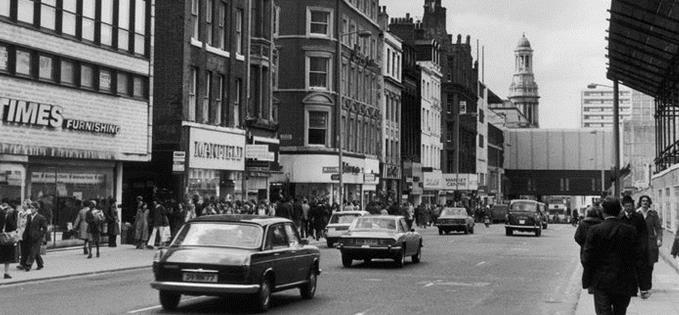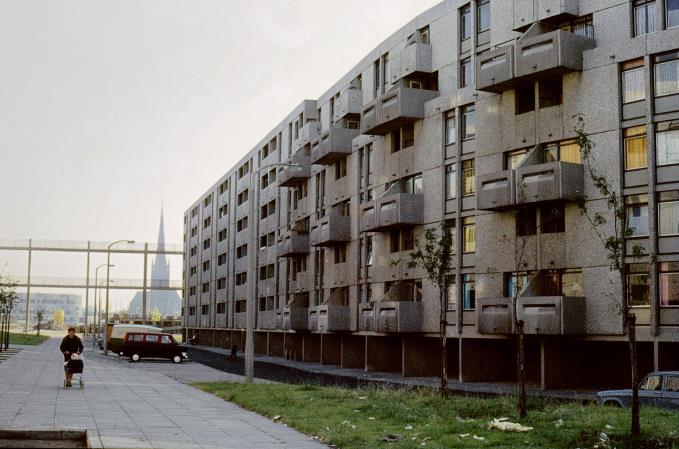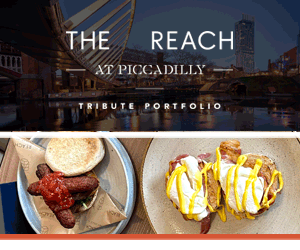BLANKET 24/7 pedestrianisation is a bankrupt policy for city centre streets in 2016. In fact for all our towns.
Permeability is everything in cities. Market Street needs its soul back
As many readers will know I am a Blue Badge Guide (an official Tourist Guide) for the North West of England and have been taking guests around Manchester for twenty years. Thus across two decades I've avoided Market Street in the evenings.
It's a deathly canyon of a place at night, the shops all closed, the shutters down, litter and rubbish spread around bins. I do this consciously. At night most Mancunians avoid malign Market Street by instinct. It's not only as ugly as sin but it feels dangerous, empty, desolate. And remember this is one of our major city centre streets.
Blanket 24/7 pedestrianisation makes councils fail their own citizens by creating no-go areas in their own centres at certain times. Councils should be doing the opposite, ensuring their town and city centres are the places that bind the rest together.
Name me one Greater Manchester pedestrianised principal street that works 24/7. The Graftons, Altrincham, ha really? High Street, Oldham? Don't make me laugh. Manchester New Road, Middleton? A total fail ruining the life of a would-be north Manchester gem.
The submersion of King Street in Stretford by the Stretford Arndale Centre four decades ago means Stretford four decades later has no town centre at all. And without a centre how can you even be a town?
Even in Scandinavia, that heaven-on-earth for most planners (who always ignore the fact that its component countries have tiny populations and provide very few workable parallels with the UK), pedestrianisation can be a blight. Strøget Street in Copenhagen is a horrible example of 24/7 blanket vehicle-banning, an utterly dreary place by night.
In our regional centre by relaxing 24/7 pedestrianisation we can also help relieve some of the unbearable tension placed on vehicle movements around the city centre by the recent traffic changes. With most north-south routes through the city centre blocked to private vehicles by tramlines (Mosley and Cross Street) or bus lanes (Portland Street) or half-gardens (Victoria Street end of Deansgate) then introducing flexibility to east-west routes such as Market Street, King Street and Brazennose Street would greatly aid movement round the city centre.
 Market Street in the Seventies with the Arndale under construction on the right. Times move on. Time to bring the traffic back.
Market Street in the Seventies with the Arndale under construction on the right. Times move on. Time to bring the traffic back.Here are my suggested changes to pedestrianisation in the city centre. There'd be a maximum speed of 20mph on the changed routes and all these routes would be for private cars, taxis and bikes, not buses or lorries.
Market Street to be opened to private vehicles, bikes and taxis between Deansgate/St Mary's Gate and Fountain Street/High Street until 11am in the morning and from 6pm in the evening during the week and Sundays. On Saturdays it would be open to traffic from 10am and then from 8pm. This was a very successful policy on Cross Street until fairly recently, ensuring the street remained animated at night and thus felt safer.
The only problem is negotiating traffic around that God-awful escalator to Manchester's most romantic dining space, the Arndale Food Court. But there is space, easily as much space as that allowed to pedestrians by the trams on Cross Street and Mosley Street. Two way traffic could easily be brought back.
The lower pedestrianised part of King Street looks set to lose more shops and gain more bars and restaurants. Bars and restaurants need an animated street so let's bring cars back. I propose a single 20mph lane to carry cars from Deansgate across the tram's 'Second City Crossing' to the wider part of upper King Street to work at a complementary time to the Market Street changes. So, the lower part of King Street would carry traffic every weekday until 6pm those allowing more people to see how its character is changing. Then it would close so the restaurants could get their tables and chairs out and bring the street to life in the evening.
Brazennose Street, again a barren thoroughfare, should also have its cars, bikes and taxis back at 20mph, this time 24 hours a day. It's another dead horror in the evening. Of course all the squares will remain traffic free, such as St Ann's and Exchange Square.
To aid traffic flows and animation I'd also re-open a single 20mph lane north on Victoria Street in front of the Cathedral and through that half-arsed 'garden' area on the other side. The whole area of Fennel Street, Cathedral Gardens will still be pedestrianised and the kids playground, presently on Victoria Street, can be moved into Cathedral Gardens, which would work well with the Corn Exchange and the National Football Museum.
The key is to be flexible. So during festivals, events and so on, there'd always be the option of closing Victoria Street again. Similarly with the other streets mentioned above.
Blanket pedestrianisation has passed its sell-by date. I sometimes think councils hold on to the symbolism of the traffic-quiet city as a civilising aspiration. This despite the manifest evidence that its application in the evening on streets such as Market Street across the kingdom does nothing but create desolate spaces.
 Lots of life, hey this looks like a proper city street. Market Street in the 1890s
Lots of life, hey this looks like a proper city street. Market Street in the 1890sBut worse, what I see with current transport policy is the last vestige of those terrible twentieth century ideas that led to the hideous debacle of Hulme Cresents, Fort Ardwick ad nauseum, and crappy enclosed shopping streets in all our centres big and small.
So instead of producing a transport infrastructure which is the most efficient for a city or a town, one which carries the most people into and out of the city centre in the best manner possible by both public and private transport, we have reached back into the middle twentieth century and attempted to construct a transport system which tells people how they ought to travel. Councils are wagging a finger at their naughty citizens saying you ought to be ashamed, use public transport.
In other words, by wrapping policy up in environmential justifications councils are once more attempting, with transport policy, to build utopias - always a dangerous game. Back in the sixties getting rid of cars in Hulme was supposed to mean all the green space and pedestrian paths between the concrete blocks both at ground level and higher up would produce a benign and civilised example of urban life. So the once incredibly vital Stretford Road, described as the second shopping street of Manchester and the first of suburban Manchester, was obliterated.
 City planning sixties style. Hey, this was a good idea, where we had a street with more than 80 shops there's now a wasteland
City planning sixties style. Hey, this was a good idea, where we had a street with more than 80 shops there's now a wasteland Morning on Market Street - it's worse at night
Morning on Market Street - it's worse at nightThe exact opposite of the dream happened. Permeability is everything in cities. Close places off and they turn inward, eat themselves. Within a couple of years everyone knew Hulme had gone wrong. Barely twenty years after construction the whole utopian scheme was cleared away and Stretford Road was put back. Indeed most of the original street pattern was put back after consultancy with the long-term Hulme residents.
It was amusing in a sick way. The planners and the architects in that classic 'we-know-what-is-best-for-you' manner had imposed a hell on a part of the city for two decades and then the people who lived there told them how ridiculous they had been. The planners and architects refused to apologise - naturally. This is happening again with Manchester's transport policy where instead of initiating schemes which work with the way people choose to travel, subtly offering alternatives, Transport for Greater Manchester and the city council are trying to coerce them into travelling the way planners have decided they should. The utter failure of the pavement extensions a couple of years ago on Deansgate dramatically illustrates this.
Of course, Market Street is not a suburban street but the parallels are striking and as with Stretford Road it needs its soul back. It needs animation when the shoppers have yet to arrive or have left.
A retrenchment, not from all pedestrianisation but from 24/7 blanket pedestrianisation, would not be a negative step, merely a practical interpretation of how the city has changed. Traffic in the morning and evening up and down Market Street would ease traffic flows and give the place life. Maybe bars and restaurants might return to that street as well. King Street and Brazennose Street would be better for limited traffic movements.
 Brazennose Street needs a livener
Brazennose Street needs a livener Traffic during day on King Street maybe, one way, 20mph, so people can drive across town from Deansgate to Chinatown. Then closed in the evening for the burgeoning bars and restaurants to set out the chairs
Traffic during day on King Street maybe, one way, 20mph, so people can drive across town from Deansgate to Chinatown. Then closed in the evening for the burgeoning bars and restaurants to set out the chairsMy colleague, Lucy Tomlinson, wrote recently how 'in propositional logic there is such a thing as the argumentum ad populum (Latin for 'appeal to the people'), which is a fallacious argument that concludes a proposition is true because many or most people believe it: this is sometimes known as “Fifty million Frenchmen can’t be wrong” or even “The entire population of Germany can’t be wrong… twice”. Despite the fact that many European countries have demonstrably been wrong, many times, we still believe in the wisdom of the crowds.'
With transport it's not the populous who believe something even though it may well be false but our doctrinaire dictators of policy, especially those involved with modelling the infrastructure of city and town centres. Perhaps argumentum ad verecundium ('appeal to false authority'). "Twenty highly-trained city planners can't be wrong", sort of thing. But as Lucy also wrote there is a 'human tendency to leap on the nearest bandwagon, even if it is going in the completely wrong direction'.
Why can't Manchester be the first city to say the experiment of blanket 24/7 pedestrianisation is as bankrupt and out-of-date as the top-down redevelopments of the 1960s? Let's liberate Market Street from the tyranny of pedestrianisation. It'd be a heroic and noble move that might act as an example to other towns and cities with botched pedestrianisation schemes. It'd make movement round the city easier for all street-users.















